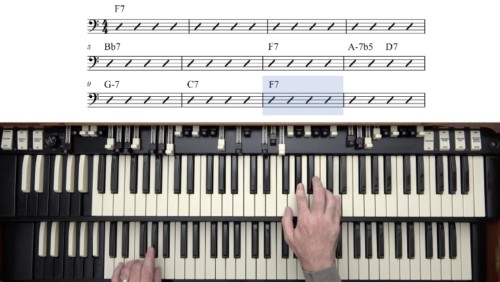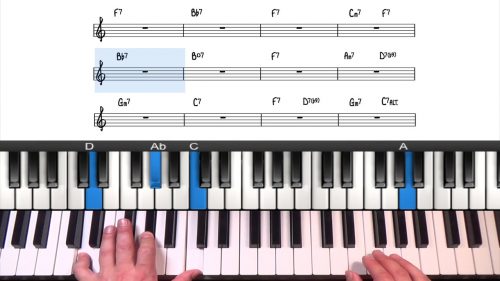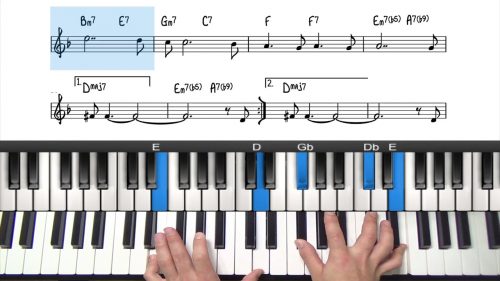Developing Your Own Soloing Ideas
In this lesson we will learn how to develop our melodic ideas for soloing and improvisation in blues, jazz, and gospel music.
The first step to developing our own ideas is to transcribe our own material from our favourite recordings and then apply those licks and lines in different settings.
Transpose & Apply Your Licks
The simplest way to get more mileage from our transcribed material is to transpose our licks and lines and then apply them throughout a chord progression.

Using the F7 lick above, we can transpose the exact notes and apply them over the other chords in the 12 bar blues, here the same lick transposed over the Bb7 chord:

This is the most basic way to reuse material and we will now explore ways to alter the rhythm to add more interest and variety to our solos.
Rhythmic Displacement
Rhythmic displacement is a simple way to construct an entire blues solo from a relatively simple melodic idea. In the below example we take the same lick and start it on beat 2 instead of beat 1:

We can also start on the “&” of each beat which creates more syncopated and interesting solo ideas and material.
Lesson Downloads
-
Transposing Licks Example File Type: pdf
-
Rhythmic Displacement Example 1 File Type: pdf
-
Rhythmic Displacement Example 2 File Type: pdf
-
Using Lick Over Different Chord Types File Type: pdf
Practice Tips
-
The preliminary step to this lesson is to transcribe a lick or a line that you personally like the sound of. We can then make this lick 'our own' by applying to different situations and displacing the rhythm.
-
Once we have transcribed a piece of melodic material, the first step is to transpose it over different chord types as we demonstrate in this lesson with the 12 bar blues in F.
-
Next we can add rhythmic displacement by starting the lick or line on different beats of the bar. Start with beats 1, 2, 3, & 4 and then displace onto the "&" of each beat to create more interesting syncopation.
-
The final step is to analyse the lick and apply to as many different chord types as possible. In this lesson we see that the exact same lick played over F7 can also be played over Gm7, Eb13#11, Dm9, Cm13, and Fmaj7.







